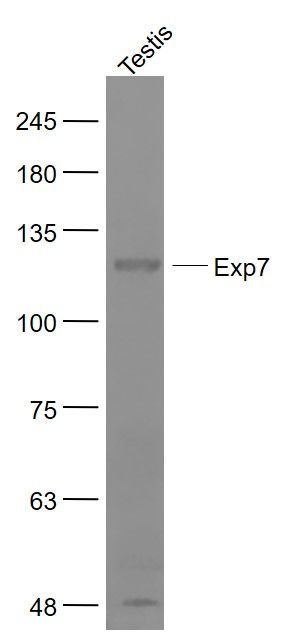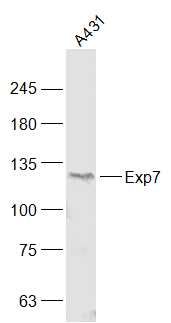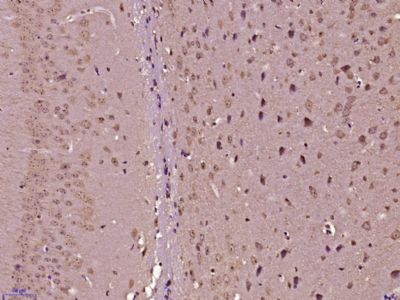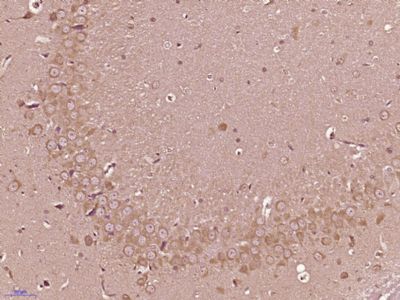The transport of protein and large RNAs through the nuclear pore complexes (NPC) is an energy-dependent and regulated process. The import of proteins with a nuclear localization signal (NLS) is accomplished by recognition of one or more clusters of basic amino acids by the importin-alpha/beta complex; see MIM 600685 and MIM 602738. The small GTPase RAN (MIM 601179) plays a key role in NLS-dependent protein import. RAN-binding protein-16 is a member of the importin-beta superfamily of nuclear transport receptors.[supplied by OMIM, Jul 2002]
Function:
Mediates the nuclear export of proteins (cargos) with broad substrate specificity. In the nucleus binds cooperatively to its cargo and to the GTPase Ran in its active GTP-bound form. Docking of this trimeric complex to the nuclear pore complex (NPC) is mediated through binding to nucleoporins. Upon transit of a nuclear export complex into the cytoplasm, disassembling of the complex and hydrolysis of Ran-GTP to Ran-GDP (induced by RANBP1 and RANGAP1, respectively) cause release of the cargo from the export receptor. XPO7 then return to the nuclear compartment and mediate another round of transport. The directionality of nuclear export is thought to be conferred by an asymmetric distribution of the GTP- and GDP-bound forms of Ran between the cytoplasm and nucleus.
Subunit:
Binds to nucleoporins. Found in a complex with XPO7, EIF4A1, ARHGAP1, VPS26A, VPS29, VPS35 and SFN. Interacts with ARHGAP1 and SFN. Interacts with Ran and cargo proteins in a GTP-dependent manner.
Subcellular Location:
Cytoplasm. Nucleus. Nucleus; nuclear pore complex. Note: Shuttles between the nucleus and the cytoplasm.
Tissue Specificity:
Strong expression in testis, thyroid and bone marrow, low expression in lung, liver and small intestine, no expression in thymus, and remaining tissues studied have moderate expression. Expressed in red blood cells; overexpressed in red blood cells (cytoplasm) of patients with hereditary non-spherocytic hemolytic anemia of unknown etiology.
Similarity:
Belongs to the exportin family.
Contains 1 importin N-terminal domain.
SWISS:
Q9UIA9
Gene ID:
23039
Database links:
Entrez Gene: 100124498 Cow
Entrez Gene: 23039 Human
Entrez Gene: 65246 Mouse
Omim: 606140 Human
SwissProt: Q9UIA9 Human
SwissProt: Q9EPK7 Mouse
| Picture |
Sample:
Testis (Mouse) Lysate at 40 ug
Primary: Anti- RANBP16/Exp7 (SL21151R) at 1/1000 dilution
Secondary: IRDye800CW Goat Anti-Rabbit IgG at 1/20000 dilution
Predicted band size: 124 kD
Observed band size: 124 kD
Sample:
A431(Human) Cell Lysate at 30 ug
Primary: Anti-Exp7 (SL21151R) at 1/1000 dilution
Secondary: IRDye800CW Goat Anti-Rabbit IgG at 1/20000 dilution
Predicted band size: 124 kD
Observed band size: 124 kD
Paraformaldehyde-fixed, paraffin embedded (Mouse brain); Antigen retrieval by boiling in sodium citrate buffer (pH6.0) for 15min; Block endogenous peroxidase by 3% hydrogen peroxide for 20 minutes; Blocking buffer (normal goat serum) at 37°C for 30min; Antibody incubation with (RANBP16/Exp7) Polyclonal Antibody, Unconjugated (SL21151R) at 1:400 overnight at 4°C, followed by operating according to SP Kit(Rabbit) (sp-0023) instructionsand DAB staining.
Paraformaldehyde-fixed, paraffin embedded (Rat brain); Antigen retrieval by boiling in sodium citrate buffer (pH6.0) for 15min; Block endogenous peroxidase by 3% hydrogen peroxide for 20 minutes; Blocking buffer (normal goat serum) at 37°C for 30min; Antibody incubation with (RANBP16/Exp7) Polyclonal Antibody, Unconjugated (SL21151R) at 1:400 overnight at 4°C, followed by operating according to SP Kit(Rabbit) (sp-0023) instructionsand DAB staining.
|
|
|



